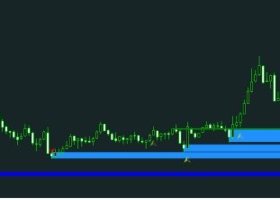Mean Reversion:
A Navigational Tool for Forex Traders
The foreign exchange market, with its constant ebb and flow, can feel like a tempestuous sea. But beneath the surface, a guiding principle exists: the theory of mean reversion. This concept posits that, over time, prices tend to gravitate back towards their long-term average. For forex traders, understanding mean reversion can be a valuable tool for navigating market volatility and identifying potential trading opportunities.
The Theory in Action
Mean reversion is a statistical concept applied to financial markets, suggesting that prices tend to gravitate back towards their historical average over time. Imagine a currency pair fluctuating around a central axis, like a pendulum. The larger the swing in one direction, the stronger the pull back towards the center.
Imagine a currency pair like EUR/USD. Over the past decade, it may have averaged a value of 1.20. A sudden surge propels the price to 1.30. According to mean reversion, this extreme deviation becomes unsustainable, and the price has a higher likelihood of correcting itself and returning closer to 1.20 in the future.

The Allure of Mean Reversion
For forex traders, mean reversion offers a strategic advantage. By identifying when a currency pair has deviated significantly from its historical average, traders can capitalize on the potential for a reversal. This can involve:
- Buying Undervalued Currencies: When a currency falls far below its historical average, it might be a buying opportunity. The expectation is that the price will eventually correct itself and rise towards the mean.
- Selling Overvalued Currencies: Conversely, if a currency surges past its historical average, it could be a good time to sell short, anticipating a decline back towards the mean.
Technical Indicators: Tools of the Trade
Several technical indicators can aid traders in identifying mean reversion opportunities:
- Moving Averages: These technical indicators depict the average price over a chosen period. A price significantly above or below its moving average suggests a potential mean reversion trade. For instance, buying a currency trading well below its 200-day moving average reflects the idea that the price may be oversold and due for a correction upwards.
- Bollinger Bands: These channel indicators depict price volatility. When prices breach the upper band, it implies overbought territory, and a potential reversion downwards. Conversely, prices hugging the lower band suggest oversold conditions and a possible upswing.
- Relative Strength Index (RSI): This indicator measures price momentum. An RSI value exceeding 70 suggests overbought conditions, while values below 30 indicate oversold territory. Traders can use these extremes as entry points for mean reversion trades.

The Reality Check: Limitations and Risks
While mean reversion offers a compelling framework, it’s crucial to acknowledge its limitations:
- Time Horizon: Mean reversion doesn’t guarantee a specific timeframe for price corrections. Trends can persist longer than anticipated, leading to losses if exit strategies aren’t in place.
- Market Fundamentals: Significant economic events or policy shifts can fundamentally alter a currency’s value, potentially rendering historical averages irrelevant.
- False Signals: Technical indicators can generate false signals, especially in volatile markets. Combining mean reversion with other technical analysis tools can help refine entry and exit points.
Expert Opinions Weigh In: Weighing the Evidence
Forex experts offer diverse perspectives on mean reversion:
- Technical analysts often emphasize mean reversion as a core trading principle. They advocate for using it in conjunction with other technical analysis tools for a more robust trading strategy.
- Kathy Lien, Forex Strategist at BK Asset Management: “Mean reversion can be a useful tool for short-term traders, but it’s crucial to combine it with other technical and fundamental analysis.“
- John Maynard Keynes, a renowned economist, believed mean reversion held true in the long term. However, he cautioned against its short-term applicability.
- “Mean reversion is a powerful concept, but it’s a tool, not a guarantee,” cautions forex analyst Lisa Jones. “Solid risk management and a healthy dose of skepticism are essential when employing this strategy.”
- “The key lies in identifying currencies with a well-established historical average and applying mean reversion during periods of range-bound trading,” advises veteran trader Michael Chen.
- Adam Chodos, Chief Investment Strategist at Interactive Brokers: “While mean reversion holds true over the long term, short-term trends can be very strong, and ignoring them can lead to missed opportunities or losses.”

The Takeaway: A Strategic Ally, Not a Holy Grail
Mean reversion is a valuable concept for forex traders. It provides a framework for understanding price movements and identifying potential trading opportunities. However, it should be used in conjunction with other analysis techniques and a healthy dose of skepticism. By understanding its strengths and limitations, traders can leverage mean reversion as a strategic ally in their quest for forex market success.
Disclaimer: This article is for informational purposes only and should not be considered financial advice. Please consult with a qualified financial advisor before making any investment decisions.
Happy trading
may the pips be ever in your favor!



